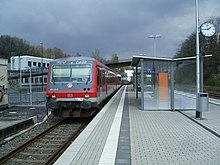Wuppertal-Ronsdorf train station
| Wuppertal-Ronsdorf | |
|---|---|
 Reception building
|
|
| Data | |
| Design | Through station |
| Platform tracks | 2 |
| abbreviation | KWRO |
| IBNR | 8006616 |
| Price range | 5 |
| opening | September 1, 1868 |
| location | |
| City / municipality | Wuppertal |
| Place / district | Ronsdorf |
| country | North Rhine-Westphalia |
| Country | Germany |
| Coordinates | 51 ° 13 '35 " N , 7 ° 12' 56" E |
| Height ( SO ) | 295 m above sea level NN |
| Railway lines | |
| Railway stations in North Rhine-Westphalia | |
The Wuppertal-Ronsdorf train station is a Wuppertal train station on the Wuppertal-Oberbarmen-Solingen line , which is now the 458 route book. The train station, which is now only operated as a stopping point , had the special feature that three different gauges met here .
location
The station is located at the end of Nibelungenstrasse in the Wuppertal district of Ronsdorf, approx. 1.2 kilometers east of the center at an altitude of 295 meters above sea level . Since the 1970s, the residential area Im Rehsiepen has been attached to the east of the station area and is connected to Ronsdorf by a pedestrian bridge over the station area.
history
The Wuppertal-Oberbarmen-Remscheid railway line
During the construction of the Rittershausen-Remscheid railway line , a route via Erbschlö was initially considered, which would have made the center of Ronsdorf better accessible. Due to the topographical conditions, however, today's route via the hamlet of Blombach was chosen as the location and further along the Tannenbaumer Weg towards Lüttringhausen - Lennep - Remscheid .
The station was inaugurated on September 1, 1868 at the same time as the railway line, which initially only ran to Remscheid.
The Ronsdorf-Müngstener Railway
The Ronsdorf-Müngstener Railway (RME) was built in meter gauge from 1890 to improve the connection to Ronsdorf and to develop the numerous metal processing companies in the Morsbachtal . On May 28, 1891, the section from the “Stadtbahnhof” to the Ronsdorf station was inaugurated, which was given the unofficial addition “State Station” (later “Ronsdorf DB”) for better differentiation. On August 21, 1891 the RME was extended to Clarenbach and on November 16 of the same year to Müngsten . In 1903 the railway line was electrified . The shutdown took place in installments until 1959.
Ronsdorf station was renamed Wuppertal-Ronsdorf station in 1949.
Three gauges
In addition to the standard-gauge state railway and the meter-gauge RME, a field railway network with a narrow gauge was built on the directly adjacent brickyard site . The brickworks and the field railway are long gone. Today the factory halls of the cable manufacturer Draka are located here . The broken edge, where the raw material for the brick production was extracted, can still be seen clearly.
The occasionally brisk transfer of goods to the RME was carried out from transfer tracks to roll stands on the narrow-gauge railway. People who changed to the tram running on the RME tracks had to take a short walk across the station forecourt.
Structural systems
The station building was a one and a half story brick building with a flat roof. To the south of this were the goods halls and other operational buildings. The former signal box at the north head has meanwhile been demolished.
Todays situation
Today's unadorned reception building no longer has any function, but only houses a kiosk. After the renovation of the station in 2006–2007, access to the central platform, which has been raised to 76 cm, is barrier-free and takes place by means of a ramp, an elevator and, alternatively, stairs. Both the old platform roofing with the cast iron columns and the former entrance through the station building and the underpass have disappeared.
The freight building is used as a warehouse, as is the RME freight hall, which was built in half-timbered construction and is still preserved today. The loading ramp , like the former house platform, has been inoperative for several years. To the east of the two tracks used by passenger traffic, there are two more, only sporadically used through tracks, which are occasionally used to park freight cars. The points and light signals are controlled from the Remscheid signal box. The remaining sidings such as B. to the factory premises of the Draka company are only occasionally used or, like the one leading to the RWE substation, have now been dismantled. There is now a scrap metal recycler at the former RME transfer station (in the southern station area).
In passenger transport , the station was to 14 December 2013. regional train The Müngstener Monday (RB 47) - Friday, served in 20-minute intervals on weekends every half hour. On December 15, 2013, the line was integrated into the S-Bahn network and was given the number S 7. The frequency remained unchanged. It runs once in the morning in the load direction to Düsseldorf from Monday to Friday.
| line | course | Tact |
|---|---|---|
| S 7 |
The Müngstener: Wuppertal Hbf Status: timetable change December 2019 |
20 min |
City bus 620 runs from the train station in the direction of Ronsdorf-Markt / Elberfeld or Klausen / Lüttringhausen . The few P + R spaces were no longer available during the renovation of the station.
literature
- Dieter Höltke; Trams and light rail vehicles in Germany, Volume 5 ; EK-Verlag GmbH; Freiburg; 1996; ISBN 3-88255-333-2
- Gerd Wolff / Lothar Riedel; German Small and Private Railways, Volume 5 ; EK-Verlag - P.O. Box 500 111; 79027 Freiburg; 1998; ISBN 3-88255-662-5
